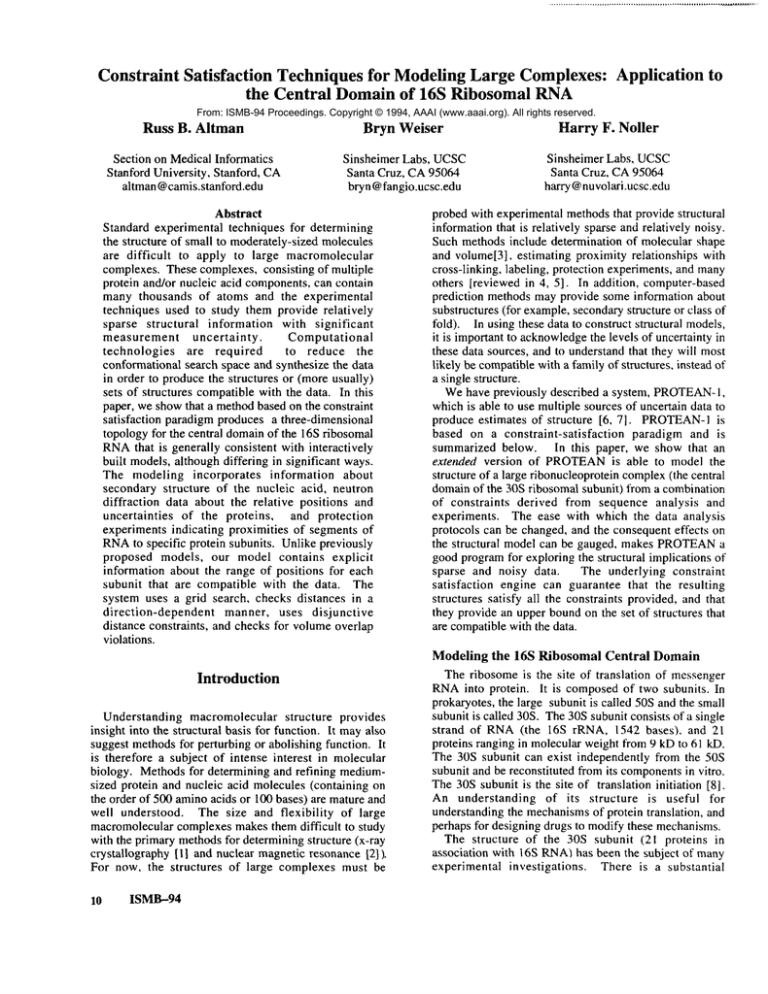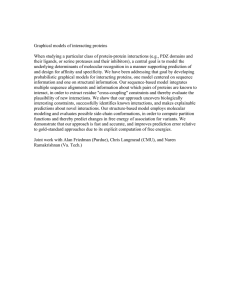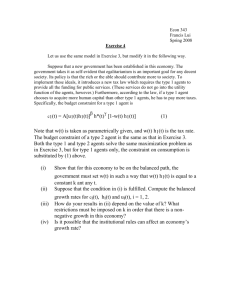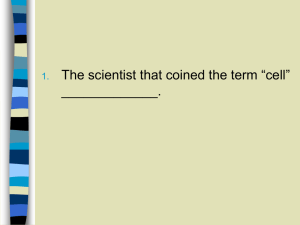
Constraint
Satisfaction
Techniques for Modeling Large Complexes: Application
the Central Domain of 16S Ribosomal RNA
to
From: ISMB-94 Proceedings. Copyright © 1994, AAAI (www.aaai.org). All rights reserved.
Russ B. Altman
Section on Medical Informatics
Stanford University, Stanford, CA
altman @camis.stanford.edu
Bryn Weiser
Sinsheimer Labs, UCSC
Santa Cruz, CA95064
bryn @fangio.ucsc.edu
Abstract
Standard experimental techniques for determining
the structure of small to moderately-sized molecules
are difficult to apply to large macromolecular
complexes. These complexes, consisting of multiple
protein and/or nucleic acid components,can contain
many thousands of atoms and the experimental
techniques used to study them provide relatively
sparse structural information with significant
measurement uncertainty.
Computational
technologies
are required
to reduce the
conformational search space and synthesize the data
in order to produce the structures or (more usually)
sets of structures compatible with the data. In this
paper, we showthat a methodbased on the constraint
satisfaction paradigm produces a three-dimensional
topology for the central domainof the 16S ribosomal
RNAthat is generally consistent with interactively
built models, although differing in significant ways.
The modeling incorporates
information about
secondary structure of the nucleic acid, neutron
diffraction data about the relative positions and
uncertainties of the proteins, and protection
experiments indicating proximities of segments of
RNAto specific protein subunits. Unlike previously
proposed models, our model contains explicit
information about the range of positions for each
subunit that are compatible with the data. The
system uses a grid search, checks distances in a
direction-dependent
manner, uses disjunctive
distance constraints, and checks for volumeoverlap
violations.
Introduction
Understanding macromolecular structure provides
insight into the structural basis for function. It mayalso
suggest methodsfor perturbing or abolishing function. It
is therefore a subject of intense interest in molecular
biology. Methods for determining and refining mediumsized protein and nucleic acid molecules (containing on
the order of 500 aminoacids or 100 bases) are matureand
well understood. The size and flexibility
of large
macromolecularcomplexesmakes them difficult to study
with the primary methodsfor determining structure (x-ray
crystallography [I] and nuclear magnetic resonance [2]).
For now, the structures of large complexes must be
10
ISMB-94
HarryF. Noller
Sinsheimer Labs, UCSC
Santa Cruz, CA95064
harry@nuvolari.ucsc.edu
probed with experimental methodsthat provide structural
information that is relatively sparse and relatively noisy.
Such methods include determination of molecular shape
and volume[3], estimating proximity relationships with
cross-linking, labeling, protection experiments, and many
others [reviewed in 4, 5]. In addition, computer-based
prediction methods mayprovide some information about
substructures (for example,secondarystructure or class of
fold). In using these data to construct structural models,
it is importantto acknowledge
the levels of uncertainty in
these data sources, and to understand that they will most
likely be compatiblewith a family of structures, instead of
a single structure.
Wehave previously described a system, PROTEAN-I,
whichis able to use multiple sources of uncertain data to
produce estimates of structure [6, 7]. PROTEAN-I
is
based on a constraint-satisfaction
paradigm and is
summarized below. In this paper, we show that an
exteruted version of PROTEAN
is able to model the
structure of a large ribonucleoproteincomplex(the central
domainof the 30S ribosomal subunit) from a combination
of constraints derived from sequence analysis and
experiments. The ease with which the data analysis
protocols can be changed, and the consequent effects on
the structural model can be gauged, makes PROTEAN
a
good programfor exploring the structural implications of
sparse and noisy data. The underlying constraint
satisfaction engine can guarantee that the resulting
structures satisfy all the constraints provided, and that
they provide an upper boundon the set of structures that
are compatiblewith the data.
Modeling the 16S Ribosomal Central Domain
The ribosome is the site of translation of messenger
RNAinto protein. It is composedof two subunits. In
prokaryotes, the large subunit is called 50S and the small
subunit is called 30S. The30S subunit consists of a single
strand of RNA(the 16S rRNA, 1542 bases), and
proteins ranging in molecular weight from 9 kD to 61 kD.
The 30S subunit can exist independently from the 50S
subunit and be reconstituted from its componentsin vitro.
The 30S subunit is the site of translation initiation [8].
An understanding of its structure is useful for
understanding the mechanismsof protein translation, and
perhaps for designing drugs to modifythese mechanisms.
The structure of the 30S subunit (21 proteins in
association with 16S RNA)has been the subject of many
experimental investigations. There is a substantial
amount of information about close contacts between
elements of the structure, and this has led the proposal of
several structures using different computational methods.
Hubbard and Hearst have used distance geometry to
model the RNAstructure [9]. Harvey and co-workers
have used molecular mechanicsmethods[10]. Stern et al.
have published a model built with interactive
graphics [ 11 ]. A common
problemfor all these methodsis
the difficulty in resolving apparently incompatible
experimental constraints. Someof these methods seek
only a single best structure and do not characterize the full
set of structures that are compatible with the data
interpretation.
Multiple runs from multiple starting
positions maygive a feel for the range of legal structures,
but can be skewedby systematic biases in sampling [12].
Weare therefore interested in applying structure
determination methodsthat give a sense of the full set of
allowed structures, and which permit the computational
protocol to be easily modified.
Constraint Satisfaction
in PROTEAN
The PROTEAN
program was originally written for the
calculation of protein structure from NMR
data [6, 7].
Formally, the program implements a simple kind of
constraint satisfaction network[28]. The objects within a
structure are the nodes in the network (see Figure 2).
Their labels are the set of discrete, legal positions. If
constraints are applied which reduce the list of legal
positions in a mannerthat dependsonly on the identity of
the node (and its interactions with the global coordinate
system), then the network achieves first order (node-)
consistency. Secondorder (arc-) consistency refers to the
state of the networkwhenall constraints which dependon
the values of two nodes are satisfied. In general, Nthorder consistency refers to states in whichall constraints
involving n nodes or less are satisfied. 1 The discussion
that follows mapsthese concepts to our implementation.
Related forms of constraint satisfaction have been used
for modelingprotein structure using symbolic logic in the
context of reasoning about protein folds [13], and for
modeling RNAstructure using discrete conformational
sets at a finer level of representation[14, 15].
In PROTEAN,
objects (nodes) are modeled as spheres
or cylinders (or combinationsof spheres and cylinders).
Each possible location (label) is represented by
translation and rotation matrix. An anchor coordinate
systemis defined by fixing the location and orientation of
one componentof the structure. The remaining objects
must have their positions defined relative to this global
coordinate system.
I path consistency is the state of Nth order consistency
when N is the total number of nodes in the constraint
network. It guarantees that all labels for each node are
part of at least one solutionthat satisfies all constraints.
Achieving First Order Consistency
If an object has direct distance constraints to the
object(s) within the anchor, then the programsamples all
possible translations and rotations for the object (using
grid search on both the position of a central point and the
orientation of the object) and checks if all the distance
constraints are satisfied. A list of compatiblelocations is
retained and constitutes the initial set of allowedlocations
for the object, which is called an anchoree. After all
anchoreeshavetheir initial set of positions, based only on
constraints to the anchor, the networkachieves first order
consistency (the locations for each object dependonly on
their identity and their relation to the fixed coordinate
system).
If an object has no direct distance constraints to the
anchor, but has constraints to an anchoree, then the
locations of that object in the space of the anchor can be
determinedin a straightforward calculation that crosses all
the locations of the object to the anchoree with all the
locations of the anchoreeto the anchor.
AchievingHigher Order Consistency
Onceall objects have been introduced into the anchor
coordinate system, then the constraints betweenthem can
be used to further prune the lists of possible locations,
using the yoke operation (a check for arc consistency).
For example, a distance constraint between two objects
can be used to prunetheir respective lists by checkingall
possible pairs of locations. If an object has a location for
whichthere are no locations for the other object that allow
the distance to be satisfied,
then this location is
eliminated. After all objects have been yoked, the
networkachieves second-order consistency.
In general, groups of N objects can be tested with
constraints (such as van der Waals overlap) that depend
on the locations of all n objects (this is referred to as Nyoking--the yoke operation is really a 2-YOKE).The
location lists are maximally pruned when Nth-order
consistency is achieved. At this point, every location in
each list is guaranteedto be part of a structure containing
all objects and satisfying all constraints. Sucha structure
is called a coherent instance, because the labels for each
object are consistent with one another and combine to
satisfy all constraints.
In general, the computationalcomplexityof this method
is exponential in the number of objects. (If L is the
average size of the location lists, and Mis numberof
location lists, then the complexity of finding full Nthorder (path) consistency is O(LN)).This results from
fact that coherent instances must, in principle, be
generated by taking all possible combinations of
structures in each of the location lists, and seeing which
Altman
11
HIO
m
Prote in s
\
1-12
H
Figure 1A (left) The secondary structure of the central domainof 16S ribosomal RNA
and the locations of the helices used
to modelthe structure for this calculation. Someintra-helical bulges are ignored in our modeling, since such details are
belowthe sensitivity of the samplingresolution. Single stranded RNA
is represented as distance constraints betweenhelices.
Figure 1B (right). Constraint network for ribosomal 16S central domain. The node labeled "proteins" represents the
proteins whosepositions are fixed in space. The ten helices of the central domainare shownas well. All helices are nodes
in the constraint network.The arcs represent constraints. Dotted arcs represent protection constraints to proteins. Solid arcs
are covalent connectivity constraints. Since H5and H10have no direct constraints to the proteins, they must be positioned
relative to helices H4and H3, respectively, and then appendedinto the global coordinate system.
ones are compatible with constraints. Tractability is
structure of any specific ribosomal sequence, but instead
maintained by the lower order consistency checking (the
the topology commonto all ribosomes. Consideration of
N-yoking steps,which removes many locations),
by
detailed effects of different bases at different positions is
intelligent selection of the order in whichoperatiors are
relevant only at a muchfiner level of detail.
performed, as well as by judicious selection of sampling
2. The predicted secondary structure of the RNA
intervals. Wehave described a system for automatic
sequence. There have been many 16S RNAssequenced,
control of PROTEAN
that exhibits reasonable problem
and these have provided information sufficient for a
solving efficiency [16].
reliable secondarystructure prediction as shownin Figure
The PROTEAN program provides
the basic
1 [5, 20, 21]. Wedivided this structure into ten roughly
functionality for fixing the anchor, determiningthe initial
helical subunits (as shownin Figure 1), which we model
location lists, yokingthe lists, and then N-yokingthe lists
as rigid A-formhelices. Bendsand turns in the structure
before generating coherent instances as described in [7].
are accommodatedwholly at the hinge points between
It has been shown to perform well for the case of
helices. Single stranded sections of the structure are not
calculating protein structure from NMR
[17, 18J. Most
modeled explicitly: their effects as tethers between
constraints are distances-which can be pure conjunctions
helical sections are represented as distance constraints
(a list of distances frompoints within one object to points
betweenthe helical sections, as described below.
within another, all of which must be satisfied)
or
3. The positions of the 6 protein moieties (using standard
disjunctions (a list of distances between objects, only
labels, these are $6, $8, S II, S15, S16, and Si8).
somesubset of which must be satisfied). The system also
Neutron diffraction studies provide the Cartesian
checks for volumeoverlap between objects. It can also
coordinates
for the centers of mass, as well as the
use constraints on volumeand surface-buried status [19].
estimated errors in each of these coordinates [24, 251.
Weuse these positions to define a global coordinate
system into which the RNAmolecule must be placed.
Methods
The detailed structures of the 6 proteins are not known.
In calculating the structure of the central domainof 16S
Modeledsimply as spheres, the minimal(anhydrous) radii
rRNA,we used 4 sources of information:
of the proteins range from 13.8 to 16.6 A. The standard
deviation of the estimates of locations for the proteins
1. The primary structure
of the RNAcomponent.
ranges from6 A, to 17 A, in each coordinate direction.
Specifically, we modeledthe structure that includes bases
4. The results of footprinting experiments in which
567 through 883. The sequence specific effect of base
individual proteins are boundto the ribosomal RNA,and
variation is not considered in the modeling,except as they
then the complex is exposed to hydroxyl radicals-allow a reliable secondary structure to be identified (as
discussed below). Thus, we are not actually modelingthe
12
ISMB-94
Dmax-2
~Protein Radils
Surface of ellipsoid describing i~
Nstandarddeviationsof error in
location of meanposition.
J
identifying bases which are protected from the solvent by
each specific protein [22,23]. These data provide
informationthat a protein is either in direct contact with a
specific segment of RNA, or induces a cooperative
structural arrangement that leads to the segment being
buried. In general, we infer that the strongest levels of
protection are primarily due to direct protein-RNA
contacts. The detailed protection will be published
separately [23]. The data set provides approximately 7
protected RNApositions per protein. Each of the ten
helices makes between 2 and 17 contacts with roughly 2
proteins. Oneparticularly interesting wrinkle in the data
set is the fact that protection by $6 and S18 cannot be
distinguished (for experimental reasons). Thus, all
protections by $6 or S18 imply that a helix is close to
either $6 or S18 (or both). This represents a disjunctive
distance constraint.
Details of Calculation
Modelingthe proteins and their positions. The high
resolution structures of the 6 proteins in the core of the
16S subunit are not known. Their amino acid sequences,
however, are known, and this allows us to estimate the
minimal radius (the anhydrous radius) of each protein
based on the length of the sequence. In addition, the
relative positions of the centers of mass of the proteins
are reported in the neutron diffraction studies [24]. The
diffraction results also provide standard errors in each of
the coordinate directions. These errors, then imply an
error ellipsoid of possible locations for the center of mass
of the protein. This ellipsoid information is combined
with the estimate of anhydrousradius, as described below
and in Figure 2, to assign distance bounds to the
constraints provided by protection experiments. The
relative locations and errors of the proteins are shownin
Figures 3 and 4.
ModelingRNAhelices. The secondary structure of the
central domainof 16S rRNAis taken from [20, 22], and is
consistent with all of the knownribosomal sequences
(Figure I). For the purposes of this computation,
identified ten key helices which are modeledas ideal A-
Figure 2. Testing for distance of a protected
base to center of mass of protecting protein.
The mean position of the protein is shown,
along with an ellipsoid of error for its location
(for these calculations, we used 1.5 standard
deviations). The protein’s anhydrous radius is
also shown at the very edge of its possible
excursion within the error ellipsoid and
demonstrates that a protected base on the
surface of the protein might be as far as Dmax
awayfrom reported center of protein. However,
Dmax-1 is much larger than Dmax-2, and
therefore we refer to this constraint as a
directional distance constraint.
form helices. Wehave therefore neglected the possibility
of helical bends and bulges within these helices (but have
allowed bends and bulges in the intervening single
stranded RNA). Wecreated a cylinder of radius 7
oriented around the helical axis of each helix to
approximate the van der Waals volume of the helix (to
allow the programto check for overlap violations of this
volume).
Modeling covalent distances. Wedid not explicitly
model the single stranded regions connecting helices,
leaving this for future refinement calculations. Each
single stranded tether between two helices was
transformedinto a distance constraint betweenthe ends of
the helices. The bounds on this distance were derived
from analysis of the minimumand maximumdistances
observedin the transfer RNA
crystal structures.
Modelingprotection data. The most important source
of information in these experiments is the hydroxyl
radical protection data [23]. Eachof these data provides
information that a base is protected by the binding of one
of the proteins. In order to minimize the influence of
protections caused by indirect effects, we only used strong
protections. Wecannot rule out the possibility that some
base protections are actually long-range conformational
effects. However, our method can detect incompatible
constraints, and we anticipated that we might uncover
someof these.
Howdo we position a protected base relative to the
reported center of mass for a protein? First, we do not
knowexactly wherethe protein is located within the error
boundsof the neutron diffraction data, so we can accept
any location within a reasonable neighborhoodaround the
center of mass. For these experiments, we took the error
ellipsoid defined by 1.5 times the respective x, y and z
standard errors of the center of mass for each protein.
This ellipsoid contains the possible locations for the
center of mass of the protein. Second, we do not know
the shape of the protein. The anhydrous radius estimate
assumesa spherical shape. Clearly, proteins can take on
elongated, asymmetric shapes. Therefore, the actual
surface radius of a protein can exceed the anhydrous
radius by a factor of as muchas 1.5 times, or be as little as
Altman
13
Ob’~ect
N -
N - 2
N - 7
N - 10
wl
2025
la
N 158
lb
1
1
1
w’~
1231
76
1
1
1
5591
9
1
1
1
16315
949
24
4
4
H5
1382
1382
162
92
70
H6
49042
6440
4706
2745
1185
B7
6975
131
34
6
6
11924
4017
2283
1908
820
~9
186754
3296
1513
1513
875
HI0
695
695
96
96
90
CPLX
2xi038
ixi027
2xi017
2xi015
ix1014
Table 1. Reducing location lists with constraint
satisfaction operators. Samplinggrid was 7 A in position
and 45 degrees in orientation. The N = 1 (a) column
contains shows numberof locations after initial anchor
operation with loose bounds that overestimate protein
position errors, and consider $6 and S18 to be a single
protein with large errors (to obviate the need for
disjunctive constraints). N=I (b) column shows first
order consistency achieved with accurate error ellipsoids,
distance-sensitive constraints and disjunctive constraint
checking. The next three columns show number of
locations after 2, 7, and 10 order consistency. The final
row, labeled CMPLX,lists the total numberof coherent
instances (the product of location list lengths) that would
need to be tested starting with the location tables
produced at each stage. TheN-yokingoperations remove
24 orders of magnitudeof computational complexity.
0.7 times the radius (based on proteins of known
structure). Wehaveopted, for initial modeling,to use the
anhydrous radius of a spherical protein as a compromise.
Wetherefore added the anhydrous radius to the ellipsoid
defined by the standard errors to create a larger ellipsoid
which describes the statistically reasonable volumethat
contains all possible locations for points on the surface of
the protein. Although this volume is not the maximal
upper bound, it captures a wide range of protein shapes.
In the case of an extremely asymmetric protein with a
large error in its calculated center of mass, we might
actually exclude allowed locations for a given protected
base. If the proteins are globular and the center of mass
estimates reliable, then our approximationis expected to
be reasonable. Therefore, the maximumdistance of a
base from a protein, Dmax,based on the protection data,
is a function of the direction of the vector, z, from the
center of mass to the base the number, N, of standard
deviations, SD, from the center of massestimate that the
user selects, and the multiplier, F, of the anhydrous
radius that captures the expected eccentricity of the
protein:
DrmLr(Z N, F) = N x SD + F Ra
s nl,ydrou
14
ISMB-94
For the calculations reported here, we assigned N = 1.5
and F = 1.0. The interpretation of these values is shown
graphically in Figure 2.
Computational
Strategy
and Results
The constraint network for the ribosomal 16S RNAis
shown in Figure lB. Wedefined a global coordinate
systemaroundthe position of the 6 proteins, whichdefine
the anchor. Wethen applied the constraint operators
described in section 2 as follows to position the l0
helices:
1. The list of locations compatible with the direct
constraints to the proteins were calculated (with a sample
interval of 7/~ in position and 45 degrees in orientation)
for anchorees: HI, H2, H3, H4, H6, H7, H8, and H9.
The size of the initial location lists is shownin Table 1.
In general, direction sensitive constraints (based on error
ellipsoids) produced muchsmaller clouds than would
direction-insensitive upper boundsphere.
2. The 2-yoke operator was applied iteratively until no
morereductions in location list length resulted.
3. UsingH3as a fixed coordinate anchor, the locations of
H10relative to it were calculated. Theselocations were
then crossedwith all possible locations of H3in the global
coordinate systemto producea set of positions tbr HI()in
the global system. Similarly, H5 was appended into the
global system via H4.
4. With all 10 helices nowintroduced into the global
coordinate system, the yoke operator was applied to all
pairs of objects with mutual constraints. This achieves
second-order consistency, as shownin Table 1. Pairwise
satisfaction
of all distances and volume overlap
constraints is achieved.
5. Seventh-order yokes were performed on all subsets of
7 (of the 10) objects. High-order yokingchiefly reflects
the effects of the van der Waals volumeinteractions,
which are high order constraints (they depend on the
position of many helices). These yokes produced
further reduction in legal locations as shownin TableI.
6. Finally, tenth-order consistency was achieved by 10yoking all objects with one another. As can be seen from
Table 1, the product of the location table sizes (whichis
the numberof possible coherent instances that need to be
considered) with seventh-order consistency is 1.7 x 1015.
PROTEAN
can check 50 x 106 coherent instances per
hour on an HP-720 workstation. However, it prunes
branches of the tree that are determined to be
incompatible, and so has an effective speed of 5 x 109
coherent instances per hour. In order to limit the run time
complexity, we sampledthe larger location lists to about
20%of their size, to create a search space of 3 x 1010. Of
these, only 140 x 106 possible coherent instances could
not be pruned by PROTEAN,and were checked in 3
hours--producing1.3 x 106 structures that satisfy all the
......... Helix6
!:!
SI1
’-i:~:~!:?i~-..
’:"::...
....:-5
.-~-i::~i::
.......
:.g~g!:?:.:::.’.~:?:::.
~
.:::::~
:::::..::::::..
-.::::....
: ":
.:::~ ~’!’i£~i::
".:.’:5
V"-: .’:t
¯ ..+::-’:.:
:5..:.::::--:.
:~:::::. 4...:-:::.:.×-:
..
.,..~#::;......
¯ -,.
~":":::~!::
........
....:...
....
H.elix 9
Figure 3. The final location lists for Helices 6 and 9 are shownwith the fixed protein positions. For each location in the
location list, the helices are transformed to the correspondingposition and drawnas a group of dots. After all locations are
used, there is a cloud describing the spatial extent of legal positions for the he/ix. The position of the helices in the
interactively built structural model[23] is shownsuperimposedon the cloud, and occurs within the clouds calculated by
PROTEAN.
The cloud radius is equal to roughly two helical diameters. These are the largest clouds produced during the
calculation. The ellipsoids of uncertainty in position for each of the proteins are also showndrawnat 1.0 standard deviation.
constraints. The maximallyprunedset of location lists for
all objects (renormalizedto negate the effect of sampling)
is shownin Table I. The final location lists are, on
average, 0.01% of the original clouds sizes. Every
location in each list is guaranteed .to be a memberof a
structure that includes all objects and satisfies all
constraints. Figure 3 shows, for helices 6 and 9, the
neighborhoodof legal locations that are part of coherent
instances. Figure 4 showsfour of these.structures, along
with a structure generated using interactive computer
graphics [23].
The elapsed time required to calculate this structure on
an HP-720 workstation was approximately 36 hours.
Mostof this time is spent in the initial yokesof the large
location lists and in the final tenth-order consistency
check, as described above.
Discussion
These experiments demonstrate that the PROTEAN
programcan interpret experimentalconstraints for the 16S
ribosomal RNAto produce a set of structures compatible
with this data. This procedure has 4 advantages over
other methodsbased on optimization or interactive model
building, that makeit very useful for the construction of
modelsand exploration of alternative interpretations of
the experimental data. First, it uses systematic sampling
so that no possible locations (within the sampleerror) are
missed. This results in a full characterization of the
neighborhood of positions for each object that is
consistent with the data. An optimization routine (or
interactive modelbuilding approach)will find structures
that, on average, do the best at satisfying constraints, with
little indication of the reliability of the structure. Second,
the discrete sampling strategy allows us to implement
distance checksthat are sensitive to the directional errors
in the protein locations: by using error ellipsoids when
checking distances, we can ensure that distances falling
along axes with high uncertainty are checked less
stringently than those occurring along axes of lower
uncertainty. In addition, the sampling strategy allows us
to check constraints that are disjunctive (either/or) in
straightforward mannerthat is difficult to implementin
optimizing strategies. Third, the stepwise nature of the
modelingallows us to roll back the problem-solving and
test the effects of alternative data interpretations without
having to redo the entire calculation. For example, if
relatively loose bounds are used to check distances
initially, then tighter boundscan be substituted later in the
problem solving and the location lists can be further
prunedwith these constraints. 2 Fourth, by maintaining¯ a
list of legal locations, we have an upper bound on the
2 Of course, introducing looser constraints subsequently
requires resamplingto regain the locations lost to the tight
constraints.
Altman
15
!!
1
-~
1 v
t I0
t 17
=====================
......
....
i~, Hi
=====================
i:i~::~::~:;
].iiii}isi:i
II.I
II2::~i~]:~i~::~
.... "........
ll~ ....
Figure 4. Four randomlyselected structures (coherent instances) generated by PROTEAN
(perimeter), and a structure built
with interactive model building (center) with same view as in Figure 3. Helices H2 and H6are in significantly different
positions in the PROTEAN
structures versus the manualmodel. In the case of H6, the manualmodellocation falls within the
set of possible locations (as shownin Figure 4) and we havesampledother legal locations. In the case of H2,there is a single
unsatisfied distance constraint which causes PROTEAN
to eliminate the location proposed in the manual model. Both
methodsagree on the location of one end, near $8, but havedifferent orientations for the helix.
16
ISMB-94
actual solution. If other data are collected subsequently,
we can reapply the final high-order consistency check,
prune the existing location lists, and gaugethe effect of
the newdata on the structure.
In general, we have found these last two points to be
very useful in the interpretation of our data. Since the
interpretation of the hydroxyl labeling data is sometimes
ambiguous, we have established
a method for
systematically testing the implications of different data
interpretations. During this process, we have identified
someconstraints betweenH3and the proteins that are not
mutually satisfiable by any reasonable interpretation of
the data. Accordingly, these have been removed and
flagged for further experimentalvalidation.
Becausethe actual structure of the 16S ribosomeis not
known,it is difficult to validate the structures that result
from our calculation. Wecan claim internal consistency
in the sense that we knowthat each structure satisfies all
the constraints, as we have provided them. External
consistency checks must rely on comparison with other
models and other data sets. Figure 4 demonstrates the
overall similarity in fold of our structure and the
interactively built structure reported previously, and based
on the same data [23]. The most significant differences
betweenthese structures are in the positions of helices 2,
6 and 9. The positions of helices 6 and 9 are loosely
constrained in our calculation, and the interactively built
structure actually is contained within the location lists.
However,helix 2 in the interactive modeldoes not satisfy
the constraints as formulatedin the calculation. There is a
single base that does not fall within the defined distance
bounds. PROTEAN
finds an alternate position for helix
2 that satisfies all distance bounds, but introduces an
entirely different orientation.
N-way consistency for problems with distances
Wenoted during our refinement that there was little
benefit from applying medium level (n = 3,4,5)
consistency checks on the structure, in terms of the
number of locations removed from the location lists.
Table 1 showsthe effectiveness of nth-order consistency
checking. The primary reductions in cloud size camewith
the 2-way yoke and with the 7-way and 10-way yokes.
This probably reflects the types of constraints we are
using. Distance constraints can be satisfied in a network
with second order consistency, and provide powerful
restraints on the cloud size. Similarly, tests for van der
Waals overlap are most sensitive whenpositions for all
objects are being checked, since the relatively tight
packing of the protein will bring out overlap conflicts best
when many objects are being positioned.
In our
experiment, the volume overlap constraints had little
benefit for checks of order 3,4,5 and 6, but achieved good
location list reductions whenseventh-order consistency
was tested. Because high-order consistency checks
dominatethe calculation time for constraint satisfaction
problems, an understanding of whether they are likely to
be effective in pruning the location lists wouldhelp in the
efficient solution of the problem. Of course, this
observation is true of all constraint satisfaction
formulations. It appears that our representation and
constraint set can achieve lists of reasonable lengths with
second-order consistency checks, but still require highorder consistency to maximallyprune the location lists.
As we movetowards problem with more objects (such as
the full 16S ribosomal RNAcomplexwith 21 proteins and
roughly 30 helices), we will be unable to generate all
coherent instances with ~50th-order consistency checks,
and will instead have to rely on overlappinglocal regions
of high-order consistency. The local nature of our data
and the local nature of structural interactions should allow
us to create nearly minimal location lists without
explicitly checkingfull path consistency.
Conclusions
In this paper we have shownthat a discretely sampled
constraint satisfaction
approach produces a set of
structural modelsfor a large macromolecularcomplex,the
central domain of the 16S rRNAand its associated
proteins. The approach is implementedas an extension of
the PROTEANprogram, to which we have added
disjunctive constraints and direction-sensitive distance
checking. Our method provides spatial bounds for the
locations of all objects in space, and therefore producesa
family of related structures that satisfy the constraints.
The incremental nature of the calculation is useful for
dynamic modification of our data interpretation
as
problemsare encountered. The resulting structure agrees
generally with the interactively built modelbased on the
samedata set, but there are significant differences which
deserve further exploration. Weare now working on a
complete model of the 30S subunit. As an example of
constraint satisfaction, this structure determination
problem shows sensitivity
primarily to low-order
constraints (n=2) and high-order constraints (n = 7-10).
The structures that are producedare excellent candidates
for refinement using more refined atomic representations
[14, 15], optimization procedures [9, 26], parametric
constraint satisfaction engines [27], or further model
building.
Acknowledgments
RBAis a Culpeper Medical Scholar. Computing
services provided by the CAMISresource at Stanford,
NIH grant no. LM-05305. Workat UCSCwas supported
by NIHgrant no. GM-17129
(to H.F.N.) and a grant from
the Lucille P. MarkeyCharitable Trust to the CMB/RNA.
Chris Hughescreated graphics software.
Aitman
t7
References
1. Blundell,
T.L. and L.N. Johnson, Protein
Co’stallography. 1976, NewYork: AcademicPress.
2. Jardetzky,
O. and G.C.K. Roberts,
NMRin
Molecular Biology. 1981, NewYork: AcademicPress.
3. Van Holde, K.E. and W.E. Hill, General Physical
Properties of Ribosomes, in Ribosomes, M. Nomura, A.
Tissieres, and P. Lengyel, Editor. 1974, Cold Spring
Harbor Press, Cold Spring Harbor, NY:p. 53-91.
4. Noller, H.F., D. Moazed, S. Stern, T. Powers, P.N.
Allen, J.M. Robertson, B. Weiser, and K. Triman,
Structure of rRNAand Its Functional Interactions in
Translation, in The Ribosome: Structure, Function &
Evolution, W.E. Hill, Editor. 1990, Am. Soc. for
Microbiol.: p. 73-92.
5. Noller, H.F., Structure of RibosomalRNA.Ann. Rev.
Biochem., 1984.53: p. 119-162.
6. Altman, R. and O. Jardetzky,
The Heuristic
Refinement Methodfor the Determination of the Solution
Structure of Proteins from NMRData, in Nuclear
Magnetic Resonance, Part B: Structure and Mechanisms,
N.J. Oppenheimer and T.L. James, Editor. 1989,
AcademicPress: NewYork. p. 177-218.
7. Brinkley, J.F., R.B. Altman, B.S. Duncan, B.G.
Buchanan, and O. Jardetzky, The Heuristic Refinement
Methodfor the Derivation of Protein Solution Structures:
Validation on Cytochrome-b562. Journal of Chemical
Information and ComputerScience, 1988.28(4): p. 194210.
8. Hardesty, B. and G. Kramer, Structure, Function and
Genetics of Ribosomes. 1985, NewYork: SpringerVerlag.
9. Hubbard, J.M. and J.E. Hearst, Computer modeling
16 S ribosomal RNA.J Mol Biol, 1991. 221(3): p. 889907.
10. Malhotra, A., R.K. Tan, and S.C. Harvey, Prediction
of the three-dimensionalstructure of Escherichia Coli 30S
ribosomal subunit: a molecular mechanics approach.
Proc. Natl. Acad. Sci. USA,1990. 87(5): p. 1950-1954.
11. Stern, S., B. Weiser, and H.F. Noller, Modelfor the
Three-dimensional Folding of 16 S Ribosomal RNA.J.
Mol. Biol., 1988. 204: p. 447-481.
12. Metzler, W.J., D.R. Hare, and A. Pardi, Limited
Sampling of Conformational Space by Distance Geometry
Algorithm: Implications for Structures Generated from
NMRData. Biochemistr)’, 1989.28: p. 7045-7052.
13. Clark, D.A., J. Shirazi, and C.J. Rawlings, Protein
topology prediction through constraint-based search and
the evaluation of topological folding rules. Prot.
Engineering, 1991.4(7): p. 751-760.
14. Major, F., M. Turcott, D. Gautheret, G. Lapalme, E.
Fillion, and R. Cedergren, The combination of symbolic
18
ISMB-94
and numerical computation for three-dimensional
modelingof RNA.Science, ! 991. 253: p. 1255-1260.
15. Gautheret, D., F. Major, and R. Cedergren, Modeling
the three-dimensional structure of RNAusing discrete
nucleotide conformationalsets. J MolBiol, 1993. 229(4):
p. 1049-64.
16. Altman, R. and B.G. Buchanan. Partial Compilation
of Strategic Knowledge.in Sixth National Conferenceon
Artificial InteUigence. 1987. Seattle, Washington:Morgan
Kaufman.
17. Arrowsmith, C.H., R. Pachter, R.B. Altman, S.M.
lyer, and O. Jardetzky, Sequence specific H1-NMR
assignments and secondary structure of E. Coli trp
repressor. Biochemist~’, 1990.29: p. 6332-6341.
18. Arrowsmith, C., R. Pachter, R. Altman, and O.
Jardetzky, The Solution Structures of E. coli trp Repressor
and trp Aporepressor at an Intermediate Resolution.
EuropeanJournal ofBiochemisto,, 1991. 202: p. 53-66.
19. Duncan, B., B.G. Buchanan, B. Hayes-Roth, O.
Lichtarge, R. Altman, J. Brinkley, M. Hewett, C.
Cornelius, and O. Jardetzky, PROTEAN:
A NewMethod
of Deriving Solution Structures of Proteins. Bulletin of
Magnetic Resonance, 1986.8: p. I11-119.
20. Noller, H.F. and C.R. Woese,SecondaryStructure of
16S RibosomalRNA.Science, 1981. 212: p. 403-411.
21. Gutell, R.R., B. Weiser, C.R. Woese, and H.F.
Noller, Comparative anatomy of 16-S-like ribosomal
RNA. Progress in Nucleic Acid Research arut Molecular
Biology, 1985.32: p. 155-216.
22. Stern, S., T. Powers, L.-M. Changchien, and H.F.
Noller, RNA-protein Interactions in 30S Ribosomal
Subunits: Function and Folding of 16S rRNA.Science,
1989.244: p. 783-790.
23. Noller, H.F., Powers, T., Weiser, B., and Mian, S.,
unpublished.
24. Capel, M.S., et al., A complete mapping of the
proteins in the small ribosomal subunit of Escherichia
coli. Science, 1987. 238: p. 1403-1406.
25. Moore, P.B., M. Capel, M. Kjelgaard, and D.M.
Engelman, ed. Structure, Function and Genetics of
Ribosomes. ed. B. Hardesty and G. Kramer. 1985,
Springer-Verlag: NewYork.
26. Hadwiger, M.A. and G.E. Fox, Explicit distance
geometry:identification of all the degrees of freedomin a
large RNAmolecule. J Biomol Struct Dyn, 1991.8(4):
759-79.
27. Altman, RB,Probabilistic structure calculations: A
three-dimensional
tRNA structure
from sequence
correlation data. in First International Conference on
Intelligent
Systems for Molecular Biology. 1993.
Washington, DC: AAAIPress, MenloPark, CA, p. 12-25
28. Mackworth, AK, Consistency in Networks of
Relations. Artificial Intelligence, 1977, 8, p. 99- I 18





